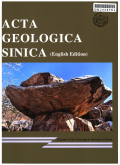- 钛学术文献服务平台 \
- 学术期刊 \
- 基础科学期刊 \
- 天文学、地球科学期刊 \
- 地质学报(英文版)期刊 \
New Discovery of~1866 Ma High-temperature Mylonite in the Helanshan Complex:Marking a Late-stage Ductile Shearing in the Khondalite Belt,North China Craton
New Discovery of~1866 Ma High-temperature Mylonite in the Helanshan Complex:Marking a Late-stage Ductile Shearing in the Khondalite Belt,North China Craton
基本信息来源于合作网站,原文需代理用户跳转至来源网站获取
摘要:
Objective
The Khondalite Belt is a nearly E-W-trending Paleoproterozoic Himalayan-type orogen in the Western Block of the North China Craton.It is regarded as a result of the collision between the northern Yinshan Block and the southern Ordos Block at~1.95 Ga,which led to the formation of the united basement of the Western Block(e.g.,Zhao et al.,2005;Yin et al.,2011).The Khondalite Belt has undergone long-term continent-continent collisional orogenic processes,and a remarkable series of late-stage orogen-parallel ductile shear zones developed(e.g.,Huang et al.,2013;Gong et al.,2014).However,the timing of these ductile shear deformations was poorly constrained because of the lack of geochronological data.This inevitably hampers a comprehensive understanding of the deformation history of the Khondalite Belt.Therefore,we carried out zircon U-Pb dating of a high-temperature mylonite from the Paleoproterozoic ductile shear zones in the Helanshan Complex,the westernmost part of the Khondalite Belt.These data will shed new light on the Paleoproterozoic tectonic evolution of the Khondalite Belt.

推荐文章
High oxygen fugacity magma: implication for the destruction of the North China Craton
High oxygen fugacity
Decratonization
North China Craton
Plate subduction
Geochemical constraints on the tectonic setting of the Sonakhan Greenstone Belt, Bastar Craton, Cent
Supra-subduction
Neo-Archean
Sonakhan Greenstone terrain
Bastar craton
Study on Late Cretaceous-Cenozoic exhumation of the Yanji area, NE China: insights from low-temperat
Low-temperature thermochronology
Exhumation
Pacific Plate subduction
Yanji area
Late Cretaceous-Cenozoic
Thermodynamic properties of San Carlos olivine at high temperature and high pressure
San Carlos olivine
Thermodynamic property
Thermal expansion
Heat capacity
Temperature gradient
内容分析
关键词云
关键词热度
相关文献总数
(/次)
(/年)
引文网络
引文网络
二级参考文献 (23)
共引文献 (37)
参考文献 (4)
节点文献
引证文献 (0)
同被引文献 (0)
二级引证文献 (0)
1992(1)
- 参考文献(0)
- 二级参考文献(1)
1993(3)
- 参考文献(0)
- 二级参考文献(3)
1995(1)
- 参考文献(0)
- 二级参考文献(1)
1996(2)
- 参考文献(0)
- 二级参考文献(2)
1997(1)
- 参考文献(0)
- 二级参考文献(1)
1999(1)
- 参考文献(0)
- 二级参考文献(1)
2000(1)
- 参考文献(0)
- 二级参考文献(1)
2001(2)
- 参考文献(0)
- 二级参考文献(2)
2002(2)
- 参考文献(0)
- 二级参考文献(2)
2005(2)
- 参考文献(0)
- 二级参考文献(2)
2006(3)
- 参考文献(0)
- 二级参考文献(3)
2007(4)
- 参考文献(0)
- 二级参考文献(4)
2009(1)
- 参考文献(1)
- 二级参考文献(0)
2011(1)
- 参考文献(1)
- 二级参考文献(0)
2012(1)
- 参考文献(1)
- 二级参考文献(0)
2014(1)
- 参考文献(1)
- 二级参考文献(0)
2021(0)
- 参考文献(0)
- 二级参考文献(0)
- 引证文献(0)
- 二级引证文献(0)
引文网络交叉学科
相关学者/机构
期刊影响力
地质学报(英文版)
主办单位:
中国地质学会
出版周期:
双月刊
ISSN:
1000-9515
CN:
11-2001/P
开本:
16开
出版地:
北京复外百万庄26号
邮发代号:
创刊时间:
1922
语种:
eng
出版文献量(篇)
3189
总下载数(次)
0
总被引数(次)
14369
期刊文献
相关文献
推荐文献
- 期刊分类
- 期刊(年)
- 期刊(期)
- 期刊推荐
力学
化学
地球物理学
地质学
基础科学综合
大学学报
天文学
天文学、地球科学
数学
气象学
海洋学
物理学
生物学
生物科学
自然地理学和测绘学
自然科学总论
自然科学理论与方法
资源科学
非线性科学与系统科学
地质学报(英文版)2022
地质学报(英文版)2021
地质学报(英文版)2020
地质学报(英文版)2019
地质学报(英文版)2018
地质学报(英文版)2017
地质学报(英文版)2016
地质学报(英文版)2015
地质学报(英文版)2014
地质学报(英文版)2013
地质学报(英文版)2012
地质学报(英文版)2011
地质学报(英文版)2010
地质学报(英文版)2009
地质学报(英文版)2008
地质学报(英文版)2007
地质学报(英文版)2006
地质学报(英文版)2005
地质学报(英文版)2004
地质学报(英文版)2003
地质学报(英文版)2002
地质学报(英文版)2001
地质学报(英文版)2000
地质学报(英文版)1999

 免费查重
免费查重










